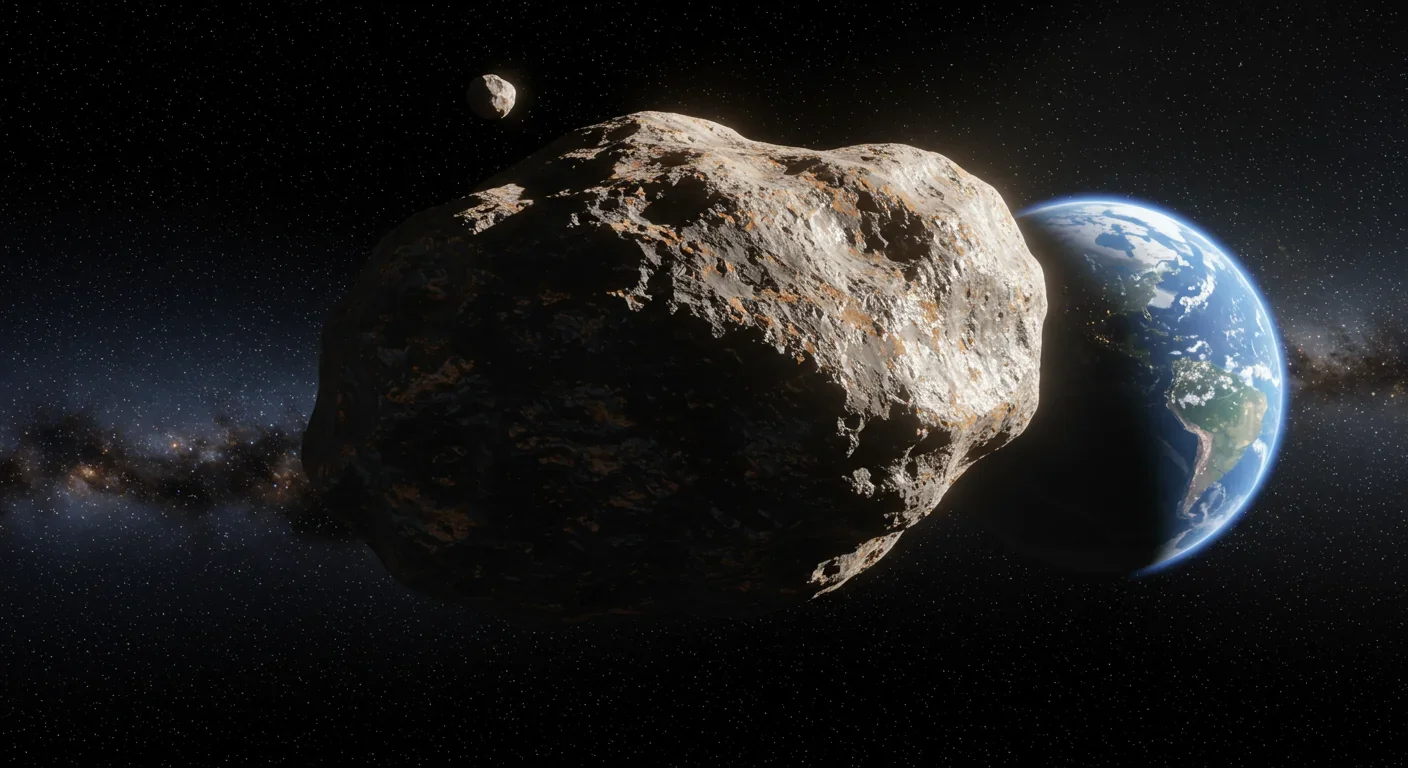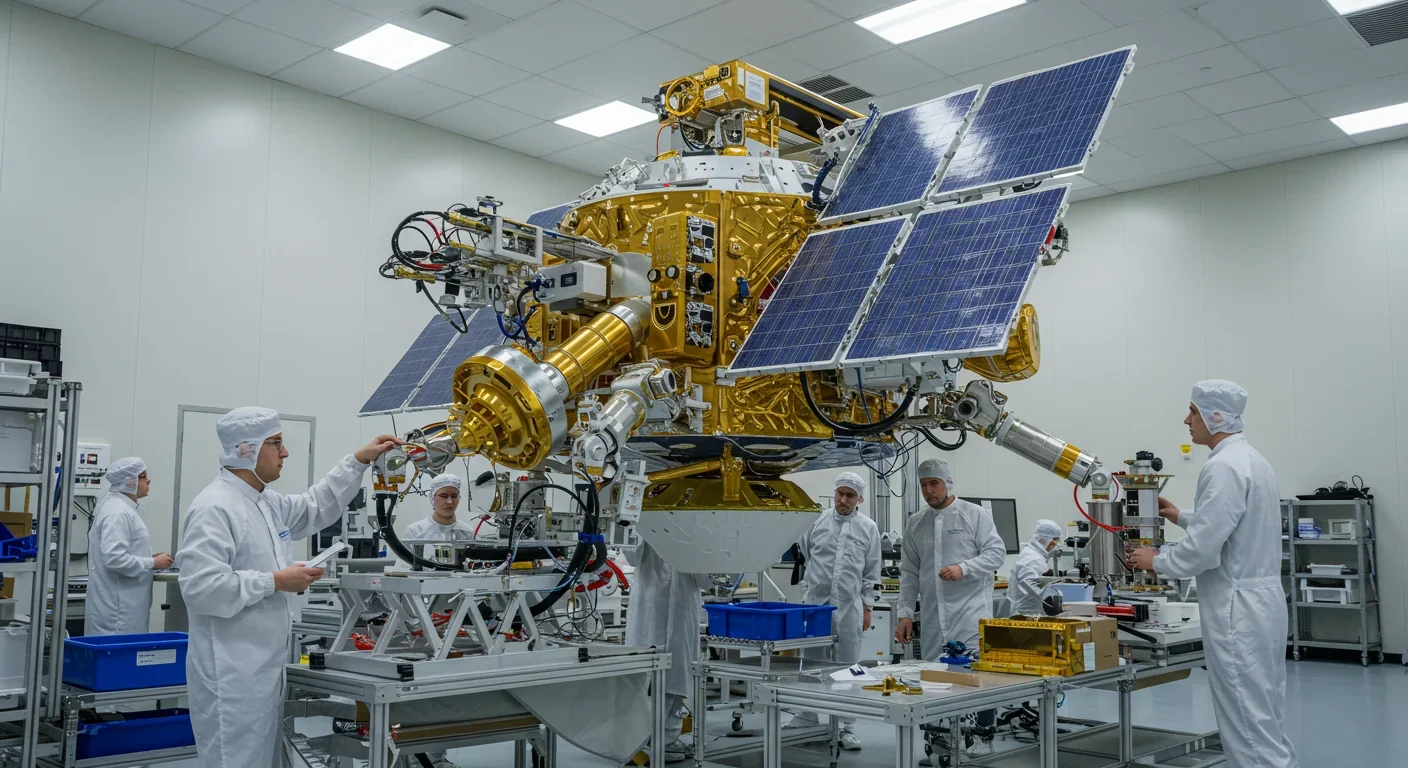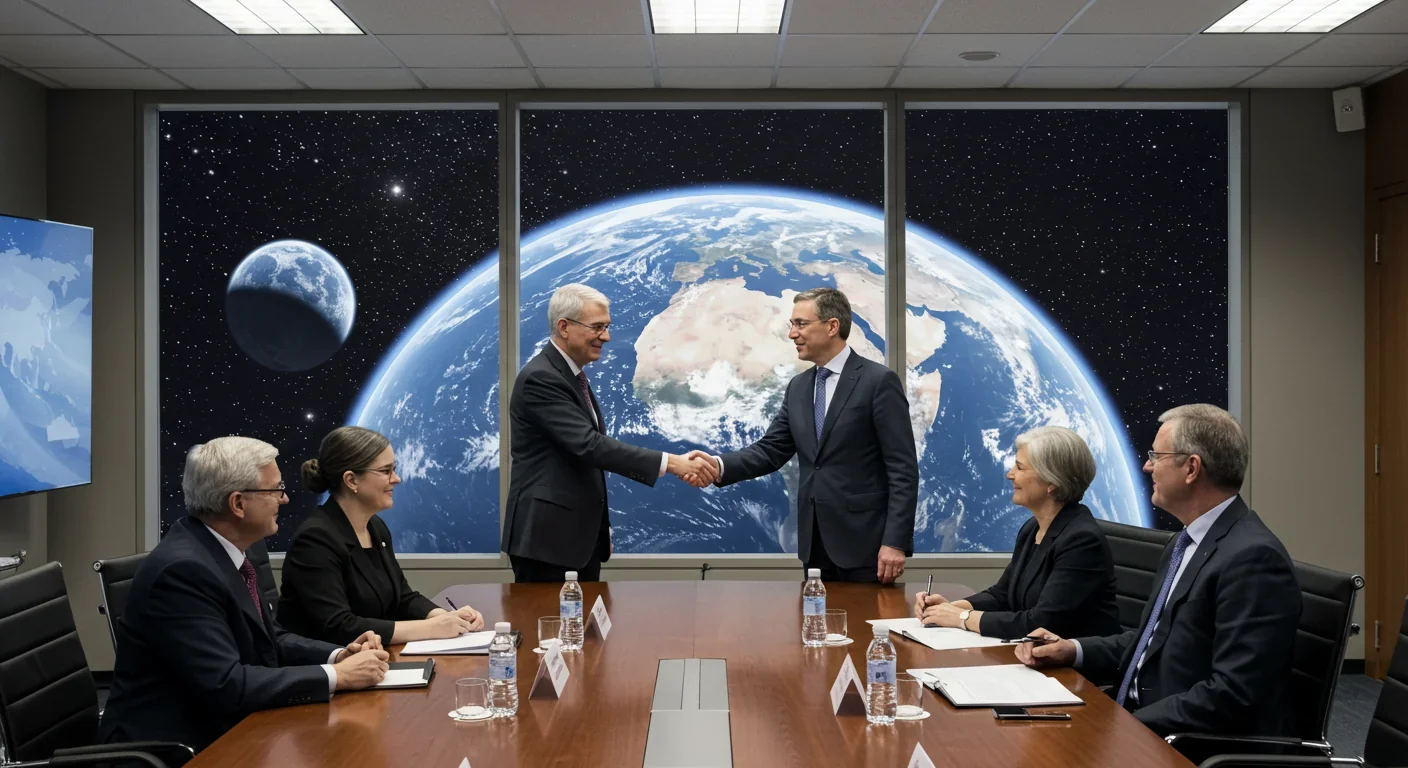Fusion Rockets Could Reach 10% Light Speed: The Breakthrough

TL;DR: Asteroids contain trillions in precious metals, but extraction costs, market paradoxes, legal ambiguity, and immature technology mean profitable mining remains 15-20 years away. The real value lies in using resources in space for fuel and infrastructure, not shipping them to Earth.

Somewhere between Mars and Jupiter, a metallic asteroid named 16 Psyche orbits the sun with a secret cargo worth more than all the billionaires on Earth combined. Scientists estimate its iron, nickel, and precious metals could be valued in the quadrillions—that's 15 zeros, enough to theoretically give every person on the planet $100 million. But before you start planning your interplanetary retirement, there's a catch: getting to those riches requires solving problems that make finding a needle in a haystack look easy.
The race to mine asteroids isn't science fiction anymore. It's a high-stakes game where venture capitalists, space agencies, and startup CEOs are betting billions on the idea that the next economic boom will happen 200 million miles from Wall Street. Yet the gap between the spectacular valuations and actual returns remains vast. Understanding which asteroids are truly worth pursuing—and what "worth" even means in the void of space—requires looking past the headlines to the hard math of orbital mechanics, market economics, and technological readiness.
When Lindy Elkins-Tanton, the lead scientist on NASA's Psyche mission, described the asteroid's value as having "15 zeros," she captured the imagination of investors worldwide. Psyche isn't alone. NASA has calculated that mining just 10 metal-rich asteroids could generate $1.5 trillion—equivalent to $100 million for every person on Earth.
These aren't wild guesses. Asteroids fall into three main categories, each with distinct resource profiles. C-type carbonaceous asteroids are rich in water, organics, and volatile compounds—essentially cosmic fuel stations. S-type silicaceous asteroids contain silicate minerals along with iron and nickel. M-type metallic asteroids like Psyche are the crown jewels, packed with platinum, cobalt, and rare earth elements that command premium prices on Earth.
The numbers are staggering. Near-Earth asteroids alone contain an estimated 50 trillion metric tons of material. Just 2-4% of these are metallic, but that sliver represents more platinum-group metals than humanity has ever mined. A single 500-meter M-type asteroid could hold more platinum than has been extracted in all of human history.
But here's where the dream meets reality: those valuations assume you can extract the resources and sell them at current market prices. That assumption collapses the moment you try to turn theory into practice.
Tel Aviv University researchers modeled what would happen if a company successfully returned a large shipment of asteroid-derived gold to Earth. Their conclusion? Prices could drop by 50% or more. This is the paradox at the heart of asteroid mining: to be profitable, you need to deliver massive quantities, but delivering massive quantities destroys the scarcity that makes the resources valuable in the first place.
It's like finding a mountain of diamonds and realizing they're only worth a fortune if you sell them one at a time over a century. The resource isn't worthless, but its value depends entirely on controlling supply—a challenge when your business model requires multi-billion-dollar missions to break even.
The space mining market is projected to grow from $1.59 billion in 2025 to $27.66 billion by 2034, a compound annual growth rate of 22.4%. Yet these projections often assume that resources will be used in space rather than shipped back to Earth—a fundamentally different business model than the "space gold rush" narrative suggests.
Right now, getting a gram of asteroid material back to Earth costs between $10 million and $150 million, based on missions like NASA's OSIRIS-REx and Japan's Hayabusa2. Both were scientific triumphs, returning pristine samples for analysis. As commercial ventures? They'd be catastrophic failures.
The technological hurdles are formidable. Mining in microgravity introduces a new class of engineering problems. How do you anchor a drilling rig when there's no gravity to hold it down? Fire up a conventional drill and the recoil sends your equipment spinning into space. Blast material loose and you create a debris cloud that could damage your spacecraft. Every operation that's routine on Earth becomes a physics puzzle in the asteroid belt.
Current technology readiness levels paint a sobering picture. Remote prospecting sits at TRL 3-4 (laboratory testing). Microgravity anchoring and mobility are at TRL 3-4. Autonomous robotic extraction is at TRL 4-5. These aren't mature technologies—they're concepts being proven in labs, not deployed at scale.
Some companies are pursuing innovative approaches. TransAstra is developing "optical mining", using concentrated sunlight to vaporize water-rich asteroids enclosed in polyamide bags. CEO Joel Sercel likens it to "wielding the sun as a blowtorch," separating volatiles from metals without traditional drilling. It's clever engineering that sidesteps microgravity anchoring issues, but it remains unproven at scale.

The infrastructure requirements are equally daunting. Mining operations need power systems that function reliably for years without maintenance. They need autonomous robots that can adapt to unexpected conditions. They need processing equipment that can refine raw ore into usable material in the harsh environment of space.
Who owns an asteroid? The question seems simple until you realize international law was written in the 1960s, before private space companies existed. The Outer Space Treaty of 1967 prohibits nations from claiming celestial bodies, but says little about private mining or resource ownership.
The 1979 Moon Agreement tried to close these gaps, declaring space resources the "common heritage of humankind." Major spacefaring nations refused to sign it. The result is a legal gray zone where national laws conflict with international treaties.
The United States and Luxembourg have passed laws granting private companies rights to extract, own, and sell space resources. These laws provide domestic legal cover for American and European companies, but they don't resolve the international ambiguity. What happens when a Chinese company and an American company both claim the same asteroid? What enforcement mechanism exists beyond Earth's atmosphere?
The United Nations Committee on the Peaceful Uses of Outer Space has no enforcement power. It relies on cooperation, not coercion. For investors, this uncertainty is a serious barrier. You can't secure financing for a $2.6 billion mission if there's a chance another country could dispute your claim to the resources.
If main-belt asteroids are the deep-ocean drilling of space mining, then mini-moons are the shallow wells. These small asteroids temporarily enter Earth's orbit, offering a tantalizing opportunity: cosmic resources that come to us.
At any given time, about a dozen small asteroids circle Earth, though most aren't large enough to justify a mission. In 2024, asteroid 2024 PT5 spent nearly two months in our vicinity. TransAstra wanted to test its optical mining system on it but missed the window.
Mini-moons offer dramatic cost savings. Missions to the asteroid belt require years of travel and massive amounts of propellant. Mini-moons are right here, accessible with far less energy and shorter mission timelines. The challenge is detection and timing—these objects appear with little warning and depart just as quickly.
The economics are different too. While you can't capture a main-belt asteroid and bring it home, mini-moons are already in Earth's gravitational neighborhood. Some researchers believe we could "park" captured mini-moons in stable orbits, creating permanent resource depots in space for less than the cost of a single Mars mission.
The history of asteroid mining companies is a cautionary tale. Planetary Resources launched in 2012 with backing from James Cameron, Google founders Eric Schmidt and Larry Page, and Virgin CEO Richard Branson. The company raised millions, developed asteroid-prospecting probes, and generated massive media attention. By 2018, it was defunct, acquired for its intellectual property.
Deep Space Industries followed a similar arc, folding into Bradford Space after failing to secure long-term funding. These failures illustrate the "valley of death" in space ventures—the chasm between promising technology and profitable operations. Venture capital cycles run 5-7 years. Space mining timelines run 15-20 years. The mismatch is fatal.
Current market projections show optimism returning. Japan's asteroid mining market alone is forecast to grow from $1.5 billion in 2025 to $9.5 billion by 2033, driven by the country's successful Hayabusa missions and expertise in robotics. Companies like ispace, AstroForge, and a revived TransAstra are betting that the next wave will succeed where the first failed.
The key difference? They're not promising to return gold to Earth. Instead, they're focused on in-situ resource utilization (ISRU)—using asteroid materials in space to support satellite operations, fuel depots, and eventually, deep-space missions. Water from asteroids can be converted into hydrogen and oxygen, providing propellant for spacecraft. Metals can be refined into structural materials for space habitats. This model avoids the market-flooding paradox by creating a closed-loop economy beyond Earth.

Forget the headline valuations. The real calculation involves orbital mechanics, composition, size, and mission costs. An asteroid is only valuable if it's economically accessible.
Delta-V is the key metric—the change in velocity required to reach an asteroid and return. Lower delta-V means less propellant, smaller rockets, and cheaper missions. Some near-Earth asteroids have lower delta-V requirements than the Moon, making them the most accessible targets.
Composition matters immensely. C-type asteroids are excellent for water and volatiles but don't contain valuable metals. M-type asteroids are metal-rich but require more complex processing. A mission to the "wrong" asteroid could spend billions extracting resources nobody wants.
Size creates a Goldilocks problem. Too small and there aren't enough resources to justify the mission cost. Too large and the gravity makes landing and anchoring more difficult. The sweet spot appears to be objects between 100 and 500 meters in diameter.
Spin rate affects operations. A fast-spinning asteroid makes landing and anchoring dangerous. Slow rotation provides stable working conditions but may indicate structural instability—a loosely-bound rubble pile that could fragment during mining.
Current candidates that balance these factors include asteroids like Bennu (already sampled by OSIRIS-REx), Ryugu (sampled by Hayabusa2), and the near-Earth asteroids 1999 JU3 and 2008 EV5. Psyche remains the ultimate prize, but its distance and size make it a second-generation target at best.
When will asteroid mining become profitable? Optimists say 15-20 years. Skeptics say never. The truth likely falls somewhere between.
Near-term missions (2025-2035) will focus on prospecting and small-scale demonstration. We'll see more sample-return missions, improved remote sensing, and probably the first attempts at resource extraction on mini-moons. These won't be profitable—they're technology development.
Mid-term (2035-2050) could see the first commercial-scale operations if technology readiness improves and legal frameworks solidify. Early operations will likely focus on water extraction for in-space propellant production. NASA and other agencies are already planning missions that could benefit from asteroid-derived fuel depots.
Long-term (2050+) might finally see profitable metal extraction, but only if orbital infrastructure develops enough to support manufacturing in space. A lunar base, Lagrange-point factories, and a network of satellites create demand for raw materials that don't need to be shipped from Earth's gravity well.
The Lagrange Space Factory concept envisions processing facilities at the L5 point, where stable orbits and continuous solar power enable year-round operations. Materials from the Moon and near-Earth asteroids could be refined and manufactured into everything from satellite components to habitat modules—all without paying the energy cost of escaping Earth's gravity.
For investors, the question isn't whether asteroids contain valuable resources—they do. It's whether the value can be extracted profitably before competitors arrive, regulations change, or technological solutions emerge that make the whole enterprise obsolete.
Current investment flows show cautious optimism. Space mining attracted approximately $120 million in private investment in 2024, a fraction of the billions going into launch services and satellite communications. Most institutional investors remain on the sidelines, waiting for technology de-risking and clearer regulatory frameworks.
Government support provides a floor under the market. NASA's Artemis program includes provisions for commercial resource extraction on the Moon, establishing precedents that could extend to asteroids. The European Space Agency and Japan's JAXA are pursuing similar policies. China's space program includes asteroid mining in its long-term vision, adding a geopolitical dimension to the race.
The risk-reward profile is extreme. A successful asteroid mining operation could generate returns that make early internet investments look modest. Failure means total loss. There's no middle ground, no "okay" outcome. You either transform the global economy or you burn billions proving it can't be done yet.
The implications extend beyond balance sheets. If asteroid mining succeeds, it could alleviate resource scarcity for critical materials. Rare earth elements, essential for electronics and renewable energy, could become abundant. Platinum-group metals, crucial for catalytic converters and hydrogen fuel cells, would no longer be supply-constrained.
But there's a darker scenario. If resources return to Earth in large quantities, commodity markets could crash, devastating mining-dependent economies. Countries like South Africa (platinum), Chile (copper), and the Democratic Republic of Congo (cobalt) could see their resource wealth evaporate overnight. The geopolitical consequences of such a shift would be profound.
The more likely scenario is that asteroid resources stay in space, fueling the next phase of human expansion. Water becomes propellant. Metals become structure. Volatiles become life support. Earth's role shifts from launching everything to orbit to being the control center for an economy that spans cislunar space and beyond.
So which asteroids are worth trillions? The honest answer is: none of them, yet. The valuations you read assume problems we haven't solved and markets that don't exist. Psyche's "quadrillion dollars" of resources are worthless if extraction costs more than they're worth or if returning them crashes commodity prices.
But the right question isn't about individual asteroids. It's about the infrastructure and technology that could make space-based resource utilization economically viable. The asteroids worth investing in are those that enable something larger—fuel depots that make Mars missions feasible, materials that build rotating habitats, water that sustains lunar colonies.
The gold rush metaphor is wrong. This isn't California in 1849, where prospectors could grab pans and start sifting streams. It's more like offshore oil drilling in the 1940s—a decades-long process of technology development, infrastructure investment, and incremental progress toward an industry that eventually generated trillions.
The companies and investors who understand this—who see asteroid mining as infrastructure rather than treasure hunting—will shape the next century of space exploration. The rest will burn their capital chasing valuations that look spectacular on paper and impossible in practice. Fifteen zeros is a big number. The number of years before someone actually profits from an asteroid might be even bigger.

Recent breakthroughs in fusion technology—including 351,000-gauss magnetic fields, AI-driven plasma diagnostics, and net energy gain at the National Ignition Facility—are transforming fusion propulsion from science fiction to engineering frontier. Scientists now have a realistic pathway to accelerate spacecraft to 10% of light speed, enabling a 43-year journey to Alpha Centauri. While challenges remain in miniaturization, neutron management, and sustained operation, the physics barriers have ...

Epigenetic clocks measure DNA methylation patterns to calculate biological age, which predicts disease risk up to 30 years before symptoms appear. Landmark studies show that accelerated epigenetic aging forecasts cardiovascular disease, diabetes, and neurodegeneration with remarkable accuracy. Lifestyle interventions—Mediterranean diet, structured exercise, quality sleep, stress management—can measurably reverse biological aging, reducing epigenetic age by 1-2 years within months. Commercial ...

Data centers consumed 415 terawatt-hours of electricity in 2024 and will nearly double that by 2030, driven by AI's insatiable energy appetite. Despite tech giants' renewable pledges, actual emissions are up to 662% higher than reported due to accounting loopholes. A digital pollution tax—similar to Europe's carbon border tariff—could finally force the industry to invest in efficiency technologies like liquid cooling, waste heat recovery, and time-matched renewable power, transforming volunta...

Humans are hardwired to see invisible agents—gods, ghosts, conspiracies—thanks to the Hyperactive Agency Detection Device (HADD), an evolutionary survival mechanism that favored false alarms over fatal misses. This cognitive bias, rooted in brain regions like the temporoparietal junction and medial prefrontal cortex, generates religious beliefs, animistic worldviews, and conspiracy theories across all cultures. Understanding HADD doesn't eliminate belief, but it helps us recognize when our pa...

The bombardier beetle has perfected a chemical defense system that human engineers are still trying to replicate: a two-chamber micro-combustion engine that mixes hydroquinone and hydrogen peroxide to create explosive 100°C sprays at up to 500 pulses per second, aimed with 270-degree precision. This tiny insect's biochemical marvel is inspiring revolutionary technologies in aerospace propulsion, pharmaceutical delivery, and fire suppression. By 2030, beetle-inspired systems could position sat...

The U.S. faces a catastrophic care worker shortage driven by poverty-level wages, overwhelming burnout, and systemic undervaluation. With 99% of nursing homes hiring and 9.7 million openings projected by 2034, the crisis threatens patient safety, family stability, and economic productivity. Evidence-based solutions—wage reforms, streamlined training, technology integration, and policy enforcement—exist and work, but require sustained political will and cultural recognition that caregiving is ...

Every major AI model was trained on copyrighted text scraped without permission, triggering billion-dollar lawsuits and forcing a reckoning between innovation and creator rights. The future depends on finding balance between transformative AI development and fair compensation for the people whose work fuels it.